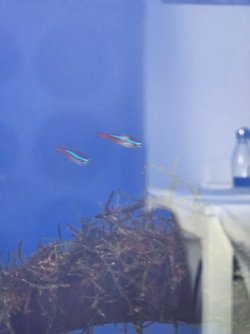KidGloves
New Member
Hello all,
I noticed a pale mark near the dorsal fin on a neon tetra (see photos below) several days ago. My first thought was columnaris or neon tetra disease so I quarantined him; however since he acts normal I'm wondering if the mark is an injury I hadn't noticed before. Any thoughts on what the mark is?
Tank size: 20 gallons
pH: 6.4
ammonia: 1-2 ppm
nitrite: 0.0-0.25 ppm
nitrate: 10-20 ppm
kH: not measured
gH: 64 ppm
tank temp: 78F
Fish Symptoms: The only visible symptom is the mark near the dorsal fin. The tetra has been eating and schooling with the other tetras as normal. I've had this tetra for a little over 3 months; he's grown considerably since the time of purchase and has seemed healthy until now. I have lost one zebra danio and one neon tetra in the last six months. I thought that the losses were age related since I purchased them over two years ago but maybe it's something else.
Volume and Frequency of water changes: 20% (~4 gallons) weekly (+/- 2 days)
Chemical Additives or Media in your tank: Aqueon water conditioner
Tank inhabitants: 4 other neon tetras, 3 zebra danios, 6 small (<1/2") black mystery snails, 6 marimo moss balls
Recent additions to your tank: The most recent additions were two neon tetras (including the one with the mark) 3 months ago.


I noticed a pale mark near the dorsal fin on a neon tetra (see photos below) several days ago. My first thought was columnaris or neon tetra disease so I quarantined him; however since he acts normal I'm wondering if the mark is an injury I hadn't noticed before. Any thoughts on what the mark is?
Tank size: 20 gallons
pH: 6.4
ammonia: 1-2 ppm
nitrite: 0.0-0.25 ppm
nitrate: 10-20 ppm
kH: not measured
gH: 64 ppm
tank temp: 78F
Fish Symptoms: The only visible symptom is the mark near the dorsal fin. The tetra has been eating and schooling with the other tetras as normal. I've had this tetra for a little over 3 months; he's grown considerably since the time of purchase and has seemed healthy until now. I have lost one zebra danio and one neon tetra in the last six months. I thought that the losses were age related since I purchased them over two years ago but maybe it's something else.
Volume and Frequency of water changes: 20% (~4 gallons) weekly (+/- 2 days)
Chemical Additives or Media in your tank: Aqueon water conditioner
Tank inhabitants: 4 other neon tetras, 3 zebra danios, 6 small (<1/2") black mystery snails, 6 marimo moss balls
Recent additions to your tank: The most recent additions were two neon tetras (including the one with the mark) 3 months ago.



